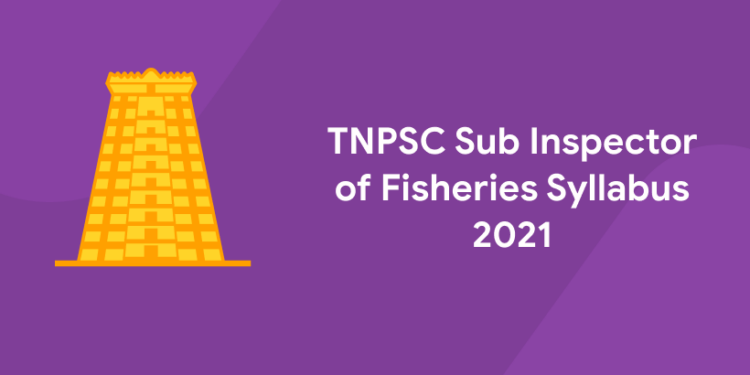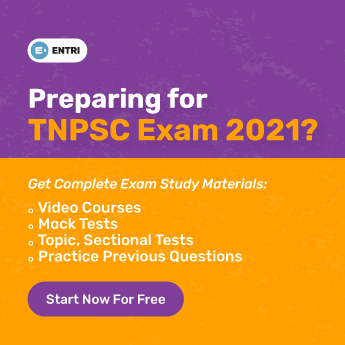Table of Contents
Syllabus and exam patterns are very much important for the preparation for any government competitive examination. The selection post is to the Tamil Nadu Fisheries Subordinate Service. The preparation plans for the examination can be prepared from the analysis of the syllabus. Paper-I for the SI post is available in three different subjects. And there is a common General Knowledge and Mental Ability paper. Aspirants can go through the detailed TNPSC Sub Inspector of Fisheries syllabus along with the examination pattern for the Tamil Nadu Sub Inspector of Fisheries.
TNPSC Sub Inspector of Fisheries – Exam Pattern
| SI Fisheries Subjects for Exam | Duration of Exam | Number of Questions | Maximum Marks |
| Paper I Subject Paper
1. Degree Standard Zoology (Code No.270) 2. Degree Standard Fisheries Science (Code No. 328) 3. Diploma Standard Fisheries Science (Code No. 327) |
3 hours | 200 Questions | 300 |
| Paper-II General Studies
Diploma Standard General Studies Aptitude and Mental Ability (SSLC Standard) |
2 hours | 100 Questions [General Studies – 75 Questions, Mental Ability – 25 Questions] | 200 |
| Interview and Records | 70 | ||
| Total | 570 |
Practice Static GK Aptitude Mock Test Series 2021
TNPSC Sub Inspector of Fisheries Syllabus 2021
Paper I – Zoology
Check the ten units to be covered under the Zoology (Degree Standard):
- Non-Chordata, Protozoa, Coelenterata, Annelida, Arthropoda, Mollusca
- Prochordata, Chordata, Pisces, Amphibia, Reptiles, Birds, Mammals
- Cell and Molecular Biology – Cellular Organelles – Structure and function, DNA structure and function, Recombinant DNA – Genetic engineering, its uses in agriculture, industries, and medicine.
- Genetics – Normal and abnormal genetic disorders; Biochemical genetics – Eugenics. Human Genome Project
- Bio-informatics – DNA and Protein sequence analysis, Prediction functional structure, protein folding, Phylogenetic tree construction
- Bio Chemistry – Structure and role of carbohydrates, lipids, proteins, and amino acids – Glycolysis and Kreb’s cycle, Physiology, Receptors- photo, phono, and chemo reception. Nephron and urine formation. Endocrine glands, testis, ovary, and pituitary organs and their interrelationship. Physiology of reproduction
- Development Biology – fertilization, Parthenogenesis, type of eggs – blastulation, cleavage, and gastrulation in frog and chick. Morphogenetic movements – organizer, potency, organogenesis
- Environmental Biology – Ecosystem- structure and function of ecosystems, types of ecosystems. Ecological succession, Community structure – Stratification. Population and Population dynamic – Habitat ecology. Wild life
- Evolution – Origin of life – Evolutionary theories – Contributions of Lamarck, Darwin, and De Vries – present status of Darwinism and Lamarckism – modern synthetic concept – Hardy Weinberg Law – Polymorphism and mimicry in evolution. Speciation
- Economic Zoology – Parasitism and Commensalism – Protozoan Parasites and diseases, helminths parasites and diseases of man and domestic animals; Beneficial and harmful insects. Insect pests on crops and stored products – Control methods
- Instrumentation and Bio-techniques topics like the Microscopy-Phase contrast, fluorescent, TEM, SEM. Colorimetric techniques, Centrifugation techniques. Fixation, staining techniques. Electrophoretic techniques: Principles, AGE and PAGE. DNA finger printing, RFLP, RAPD and AFLP
Paper I – Fisheries Science
The ten units of Fisheries Science (Degree Standard):
- Fish Biology, Fish Physiology & Fish Genetics – Binomial nomenclature: classification of elasmobranchs, teleost’s, crustaceans, and molluscs; external morphology – morphometric – meristic and anatomy of finfish and shellfish, DNA bar coding –Karyo taxonomy, Food and feeding habits
- Marine Fisheries and Population Dynamics – shellfish, crustacean, and seaweed resources of India; fish population dynamics – Vonbertalanfy’s growth equations- growth and mortality parameters
- Aquaculture, Ornamental Fish Culture, and Fish Diseases – Site selection for fish culture – cultivable fishes for freshwater- Pond chemistry – Dissolved Oxygen – Alkalinity, Hardness aquaculture, fish feeds – Pond disinfection with lime -Water quality management, integrated fish farming – sewage
- Limnology, Aquatic Ecology, and Biodiversity, Fishery Oceanography, Aquatic Pollution, Coastal Zone Management – lentic and lotic systems, flora and fauna, classification of lakes based on origin, productivity & mixing of water; phytoplankton and zooplankton, nekton, benthos, Estimation of primary production
- Fisheries Economics, Statistics, Fisheries Marketing & Fisheries Extension – Theories of demand and supply, market equilibrium, production function in capture and culture fisheries, Economics of fishing and fish farming
- Fishing Gear Technology, Fishing Craft Technology & Navigation, and Seamanship – Principles of hydrostatics, the law of floatation –Archimedes principle – Simpson’s rules Fishing craft materials – wood, steel, FRP- form co-efficient, TPC– ship’s stability– state of equilibrium care and maintenance of vessels
- Refrigeration and Equipment Engineering, Marine Engines – compression refrigeration- vapor absorption refrigeration Compressor, evaporator, condenser – Freezers – plate, blast, tunnel- refrigerated- coefficient of performance seawater systems
- Fish in Nutrition, Fish Processing Technology – Nutritional value of fish- protein, non -protein, nitrogen, lipid, minerals, micro, and macro element, trace elements, other functional biomolecules in fishes. The freshness of fish and rigor mortis – mechanisms of fish spoilage – fish drying methods – principles of salting and salt curing methods – smoking of fishes
- Fish Packaging Technology, Fish Products, and Value Addition – Fishery by products – Fish meal- fish oil shrimp waste- chitin –chitosan-fish protein concentrate- fish hydrolysate- fish silage – fish maws, fish glue- gelatin-isinglass-utilization of seaweeds –agar agar – algin – carrageenan
- Microbiology of Fish and Fishery Products, Quality Assurance of Fish and Fishery Products – Quality dimensions of sea food-assessment of quality changes in fresh and iced fish and during processing application of HACCP concept in quality assurance-Role of EIA and MPEDA in fish and fishery products
Paper I – Fisheries Technology / Fisheries Science / Fisheries Technology and Navigation Engineering (Diploma Standard)
There are Ten units for the Diploma Standard including:
- Fishery Biology – Morphometric and Meristic Characters – Length weight Relationship. Food and Feeding Habits – Reproductive Biology
- Inland & Marine Fisheries – Major Riverine fisheries of India – Lake Fisheries Reservoir Fisheries – Cold Water Fisheries – Pollution in Inland Waters
- Nautical Technology – Mercator Projections – Buoyage System – International Code flag signals –Navigational Lights-Firefighting –Strom Signals – Distress Signals
- Fish Processing Technology – the principle of fish spoilage– Rigor Mortis – Drying, Salt drying, Icing, Freezing, Canning, Fishery by-products, Fish packaging technology
- Aquaculture – Plankton – Fertilization – Aqua feeds – Pond disinfection with lime -Water quality management
- Oceanography and Meteorology – Currents- El – Nino – Salinity – Tsunamis – Weather – Climate – humidity. Tropical Cyclones – Atmospheric pressure
- Fishing Gear and Craft Technology – Fishing Gear Materials –Modern Fishing gears – Trawls, Gill, Nets, Longlines Fishing Gear Accessories
- Fishery Economics – Price, Income – Cost, returns – Marketing – Cooperatives – Socioeconomic Survey – the economics of fish and fish seed production system
- Fisheries Resource Management and Administration – Maximum Sustainable Yield (MSY), Fishing holidays, Mesh size regulations- Growth over fishing
- Fishery Electrical and Electronic Engineering – types of ponds-Pumps, Aerators, Sluice, Monk- canals-types of dykes –Classification of Engines – Marine Diesel Engines
Paper-II – General Studies (Diploma Standard)
General Science
The science includes the three subjects Chemistry, Biology (Botany and Zoology), and Physics. Check the detailed syllabus:
- Physics – Includes the topics like Nature of Universe‐General Scientific Laws‐Inventions and discoveries‐National scientific laboratories‐Mechanics and properties of matter‐Physical quantities, standards and units‐Force, motion and energy‐Magnetism, electricity and electronics‐ Heat, light, and sound.
- Chemistry ‐ Includes Elements and Compounds‐Acids, bases and salts‐Fertilizers, pesticides, Insecticides.
- Botany‐ Includes Main Concepts of life science‐Classification of living organism‐Nutrition and dietetics‐Respiration.
- Zoology‐Topics like Blood and blood circulation‐Reproductive System‐Environment, ecology, health and hygiene‐Human diseases, prevention and remedies‐Animals, plants and human life.
Current Events
- History topics comprising latest diary of events‐national ‐National Symbols‐Profile of States‐Eminent persons & places in news‐Sports & games‐Books & authors ‐Awards & honors’‐India and its neighbors.
- Political Science topics like the problems in the conduct of public elections‐Political parties and political system in India‐Public awareness & General Administration‐Welfare oriented govt. schemes, their utility.
- Geography Includes the topics of landmarks
- Current socio‐economic problems.
- Latest inventions in science & technology.
Geography
Comprises the Earth and Universe‐Solar System‐Monsoon, rainfall, weather & climate‐Water resources ‐ rivers in India‐Soil, minerals & natural resources‐Forest & wildlife‐Agricultural Pattern Transport & communication‐Social geography – population‐density and distribution‐Natural calamities – Disaster Management
History And Culture of India and Tamil Nadu
Both Indian and specifically the Tamil Nadu including Indus valley civilization‐Guptas, Delhi Sultans, Mughals and Marathas‐Age of Vijayanagaram and the bahmanis‐South Indian History‐Culture and Heritage of Tamil people‐India since independence‐Characteristics of Indian Culture‐Unity in diversity – race, color, language, custom‐India‐as secular state‐Growth of rationalist, Dravidian movement in TN‐Political parties and populist schemes
Indian Polity
- Constitution of India‐‐Preamble to the constitution‐ Salient features of constitution‐ Union, state and territory‐ Citizenship‐rights amend duties‐ Fundamental rights‐ Fundamental duties‐ Human rights charter‐ Union legislature – Parliament‐. State executive.
- State Legislature – assembly‐ Local government – panchayat raj – Tamil Nadu‐ Judiciary in India – Rule of law/Due process of law‐. Elections‐. Official language and Schedule‐VIII.
- Corruption in public life‐. Anti‐corruption measures –CVC, Lok adalats, Ombudsman, CAG‐ Right to information‐ Empowerment of women‐ Consumer protection forums.
Indian Economy
Nature of Indian economy‐ Five‐year plan models‐an assessment‐Land reforms & agriculture‐Application of science in agriculture‐Industrial Growth‐Rural welfare-oriented programmers‐Social sector problems – population, education, health, employment, poverty‐Economic trends in Tamil Nadu.
Indian National Movement
Includes the topics of movement like National Renaissance‐‐Emergence of national leaders‐Gandhi, Nehru, Tagore‐Different modes of agitations‐Role of Tamil Nadu in freedom struggle Rajaji, VOC, Periyar, Bharathiar
Economics and Commerce
Village and Rural Development in India. Agriculture, Major crops and crop pattern in India, Industrial Development, Major medium, small scale and cottage Industries of Tamil Nadu. Housing, Drinking water and other developmental schemes – price policy, Inflation, population and unemployment problems, imports and exports
Aptitude & Mental Ability Tests (SSLC Standard)
- Simplification – Percentage – Highest Common Factor (HCF) – Lowest Common Multiple (LCM)
- Diagrams‐Parametric representation of data‐Analytical interpretation of data
- Ratio and Proportion
- Simple interest – Compound interest – Area – Volume – Time and Work
- Logical Reasoning – Puzzles-Dice – Visual Reasoning – Alphanumeric Reasoning – Number Series
Download TNPSC Sub Inspector of Fisheries Syllabus PDF
Both Paper I and Paper II of the exam syllabus PDF free download. Get the links below:
- Download the complete PDF for the Zoology (Degree Standard) Syllabus
- Download the complete Fisheries Science (Degree Standard) Syllabus PDF
- Download the complete Syllabus PDF of Fisheries Technology / Fisheries Science / Fisheries Technology and Navigation Engineering (Diploma Standard)
- Download the complete Syllabus PDF for the General Awareness and Aptitude
Get the subject-wise notes for the current affairs and attempt practice quiz
The complete syllabus and exam pattern for the TNPSC Sub Inspector of Fisheries has been discussed above. To conclude, the syllabus helps candidates to prepare for the exam. The TNPSC releases a syllabus, following which the written exam and interview will be held. Go through the discussed topics, and schedule your preparation according to the graduation subject. Follow this page for all the TNPSC Fisheries SI exam updates. Good Luck aspirants!













